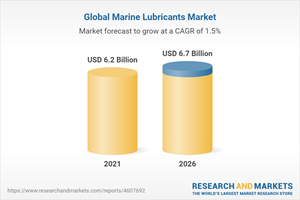Global Marine Lubricants Market 2022: Increasing Demand for Bio-Based Marine Lubricants Presents Opportunities

Global Marine Lubricants Market

Dublin, Sept. 06, 2022 (GLOBE NEWSWIRE) -- The "Marine Lubricants Market by Oil Type (Mineral Oil, Synthetic, Bio-based, and Grease), Product Type (Engine oil, Hydraulic fluid, Compressor oil), Ship Type (Bulk Carrier, Tanker, Container) and Region - Global Forecast to 2026" report has been added to ResearchAndMarkets.com's offering.
The marine lubricants market size is estimated to be USD 6.2 billion in 2021 and is expected to reach USD 6.7 billion by 2026, at a CAGR of 1.5% during the forecast period. The marine lubricants market is mainly driven by the emerging emission abatement technologies, growth in maritime tourism and the infrastructural developments that are strengthening the shipping industry. The impact of Covid-19, and shift towards synthetic-based lubricants are the key restraints in the marine lubricants market. However, the growing demand for bio-based marine lubricants offers opportunities to the marine lubricants manufacturers.
Infrastructural developments strengthening the shipping industry is one of the factors driving the growth of the market
According to the International Chamber of Shipping (ICS), a principal global trade association for the shipping industry, it is estimated that around 90% of the global trade is carried out by the shipping industry. This is supported by the ship manufacturers and government bodies that help increase marine trade by increasing the size of ships, develop new terminals, and create bigger straits along with the expansion of the existing ones such as Panama and Suez 1Canals.
Both these canals are the two most important strategic waterways that are part of more than 100 trade routes. In addition, the large shipping companies are expanding their network by acquiring new ports in various regions. The increasing size and load carrying capacity of vessels have led to rising trade volumes with focus on the development of more durable and sturdier marine crafts. The demand for ultra large container ships (ULCS) is increasing and is expected to reduce the slot-costs. This is favored by shipping companies, as these large ships will help them catch up with the prime movers.
Mineral oil is estimated to be the largest oil type in the marine lubricants market in 2020
The mineral oil marine lubricants segment is projected to register the lowest CAGR in terms of value, between 2021 and 2026, as they are being replaced by less toxic marine lubricants such as synthetic and bio-based lubricants. Mineral oil based lubricants are being replaced by these less toxic lubricants due to stringent governmental norms for environment protection.
In spite of the gradual shift from mineral oil lubricants to synthetic and bio-based lubricants, bulk lubricant applications such as marine 2-stroke and 4-stroke engines, propulsion units, and stern tubes will continue to utilize large volumes of mineral oil lubricants because of its low cost.
Market Dynamics
Drivers
Infrastructural Developments Strengthening the Shipping Industry
Emerging Emission Abatement Technologies
Growth in Maritime Tourism
Restraints
Shift Toward Synthetic Lubricants May Increase the Drain Interval
Impact of COVID-19
Opportunities
Increasing Demand for Bio-Based Marine Lubricants
Shift from Group-I to Group-Ii Base Stocks
Challenges
Stringent Environmental Norms and Continuous Reforms by Governments
Volatility in Raw Material Prices
Key Topics Covered:
1 Introduction
2 Research Methodology
3 Executive Summary
4 Premium Insights
5 Market Overview
6 Industry Trends
7 Marine Lubricants Market, by Oil Type
8 Marine Lubricants Market, by Product Type
9 Marine Lubricants Market, By Ship Type
10 Marine Lubricants Market, by Region
11 Competitive Landscape
12 Company Profiles
13 Adjacent & Related Markets
14 Appendix
Companies Mentioned
Addinol Lube Oil Gmbh
Bel Ray Company LLC.
Bp plc.
Cepsa
Chevron Corporation
China Petrochemical Corporation (Sinopec Corp.)
Dyade Lubricants
Emirates National Oil Company (Enoc)
Eni S.P.A.
ExxonMobil Corporation
Gazprom Neft
Gulf Oil International
Idemitsu Kosan Co. Ltd
Indian Oil Corporation
Jx Nippon Oil & Energy Corporation
Liqui Moly Gmbh
Lukoil
Morris Lubricants
Penrite Oil
Petrochina Company Limited
Petronas
Royal Dutch Shell plc
Sk Inc.
Totalenergies Se
Valvoline
For more information about this report visit https://www.researchandmarkets.com/r/ix00cj
Attachment
CONTACT: CONTACT: ResearchAndMarkets.com Laura Wood,Senior Press Manager press@researchandmarkets.com For E.S.T Office Hours Call 1-917-300-0470 For U.S./ CAN Toll Free Call 1-800-526-8630 For GMT Office Hours Call +353-1-416-8900


 Yahoo Finance
Yahoo Finance 
